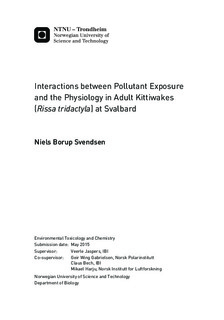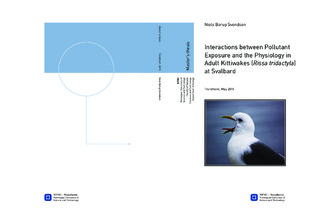| dc.description.abstract | This study investigated the use of feathers as a useful non-destructive biomonitoring tool for novel organic pollutants in black-legged kittiwakes (Rissa tridactyla), and evaluated the interaction of both novel and legacy pollutants on body condition and thyroid hormones. In July 2014, feather and blood samples were collected from 20 black-legged kittiwakes (Rissa tridactyla) at two colonies (Blomstrandhalvøya and Krykkjefjellet) in Kongsfjorden, Svalbard. Samples were analyzed for polychlorinated biphenyls (PCBs), polybrominated diphenylethers (PBDEs), organochlorine pesticides (OCPs) and phosphorous flame retardants (PFRs).
All compound classes were detected and quantified in feathers ranging from <2.38 to 6.72 ng/g wet weight (ww) for sum PCBs, <1.23 to 7.81 ng/g ww for sum PBDEs, <0.99 to 14.2 ng/g ww for sum OCPs, and <1 to 15.6 ng/g feather for sum PFRs. This confirms the suitability of kittiwake feathers for quantification of both legacy and novel pollutants. Strong significant differences (p<0.001) in organic pollutant levels were found in plasma, but not in feathers, between the colonies (total POP load in plasma mean±SE: 72.7±8.62 ng/g ww for Blomstrandhalvøya; 29.6±1.67 ng/g ww for Krykkjefjellet). None of the investigated compounds in feathers correlated with plasma levels, which suggest that kittiwake feathers reflect contamination from the wintering areas where the feathers were grown, whereas plasma levels reflect pollution at the breeding areas at Svalbard.
Significant negative correlations between the ratio of total iodothyronine (TT3) to free iodothyronine (fT3), and CB 28, -138, and -187, BDE 47, and sum PBDE (mainly BDE 47) were found for kittiwakes from Blomstrandhalvøya only (all r ≥ -0.60 and p ≤ 0.05). The endocrine disrupting abilities of PCBs and PBDEs seem to be of concern in the kittiwakes, since the kittiwakes with the higher levels of circulating levels of pollutants from Blomstrandhalvøya were significantly affected. In addition, body condition of birds from both colonies was significantly negatively correlated with most OCPs, and PCBs. Altogether, these results show an additional stress factor to kittiwakes caused by exposure to organic pollutants in an already stressful breeding period at Svalbard. | |

